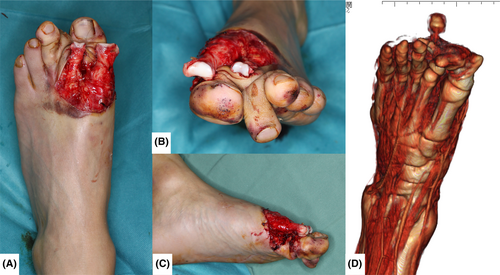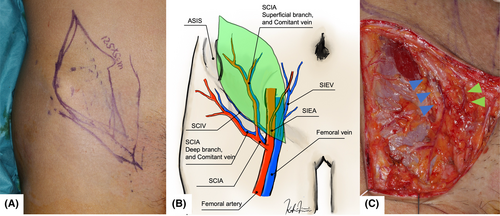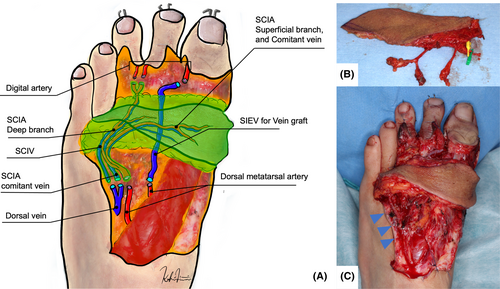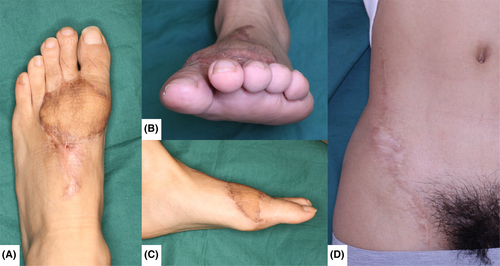Immediate foot reconstruction and revascularization of toes using an interposition superficial circumflex iliac artery perforator flow-through flap: A case report
Abstract
Foot injuries, particularly degloving injuries, can lead to segmental loss of neurovascular structures in the toes, making simultaneous reconstruction of both the foot and toes challenging. This case report presents a technique using the superficial circumflex iliac artery perforator (SCIP) flap for immediate reconstruction of the dorsal foot and revascularization of multiple toes. A 28-year-old man suffered a degloving injury on the dorsum of his foot resulting in a 9 × 6cm skin defect, open fracture dislocations, exposure of tendons, and neurovascular injury, which included a 6–7.5 cm segmental defect of the vessels supplying the first, second, and third toes leaving all three toes ischemic. Immediate reconstruction was performed by harvesting a 12.5 × 5cm SCIP flap including both the superficial and deep branches and incorporating the superficial inferior epigastric vein (SIEV). The SCIP deep branch was used to revascularize the third and second toes and the SIEV vein graft used for the first toe. The patient recovered well, no complications were observed at the 2-year follow-up, preserving all three toes and regaining mobility. The use of the SCIP flap as a flow-through flap provides thin skin flap cover, good vessel caliber size match with digital vessels and reduces the need for vein grafts from distant sites improving surgical efficiency. These attributes make the flow-through interposition SCIP flap an excellent choice for reconstructing foot defects and revascularizing toes. We report this case to demonstrate the utility of the SCIP flap in immediate soft tissue cover and digit revascularization.
1 INTRODUCTION
Injuries of the foot may cause impairment of blood flow to the toes (Gustilo et al., 1984; Ricci et al., 2019). Degloving injuries of the foot in particular, are often accompanied by avulsion of the neurovascular supply of the toes resulting in segmental loss of vasculature (Gustilo-Anderson IIIC). This makes it challenging to reconstruct degloving defects of the foot and the toes at the same time due to the need for multiple vein grafts with limited time for harvest of the grafts, toe revascularization, flap harvest, and coverage of the skin defect (Tang et al., 2013). The superficial circumflex iliac artery perforator (SCIP) flap has been used as a major free flap in lower extremity reconstruction since it was first reported in 2004 (Abdelfattah et al., 2019; Koshima et al., 2004). It has a variety of applications and is still an evolving flap. However, there are limited reports on its application in immediate simultaneous foot reconstruction and revascularization of toes to date. (Narushima et al., 2018; Yamamoto et al., 2021) In this case report, we present a case in which a flow through SCIP flap was used for reconstruction of the foot following degloving injury with open fracture dislocation of the toes and Gustilo-Anderson IIIC neurovascular injury. We report this case to demonstrate the utility of the SCIP flap in immediate tissue cover and digit revascularization due to the relative abundance and size match of the SCIP vessels with digital vessels in the extremities, and the availability of thin pliable skin for soft tissue cover.
2 CASE REPORT
A 28-year-old man suffered a degloving injury on the dorsum of his left foot after his shoe was caught in a caterpillar industrial tractor. The resulting wound included a moderately large skin defect (Figure 1a,c) extending to the distal foot, with open fracture dislocations of the metatarsal phalangeal joints of the first, second, and third toes, damage of the paratendons with exposure of tendons and neurovascular injury of the affected toes distally (Gustilo-Anderson IIIC). There was no perfusion in all three injured toes (Figure 1d), so emergency surgery was performed immediately to restore perfusion and cover the soft tissue defect.

The vessels of the foot were found to be severely contused and torn, with both the dorsal and proper plantar digital arteries in the affected toes also contused and torn resulting in a considerable vessel deficiency of 6–7.5 cm between the healthy ends of the vessels. The decision was made to perform reconstruction of the dorsum of the foot and revascularization of the toes using the SCIP flap and its associated vessels. (Figure 2a,b).

The flap was designed with the vascular run of the flap accurately confirmed by ultrasound. First, wires were inserted to fix the dislocated bones while the SCIP flap was elevated from the right inguinal region. The SCIP flap was elevated to include the deep and superficial branches of the superficial circumflex iliac artery (SCIA), superficial circumflex iliac vein (SCIV), and the comitant vein of the SCIA. These branches were dissected by using a proximal-to-distal elevation technique (Figure 2c) (Yoshimatsu et al., 2016). A longer distal pedicle was taken for interposition and a superficial inferior epigastric vein (SIEV) was harvested as a vein graft (Figure 3a,b).

Prior to anastomosis the toe bones were fixed using two 0.9 mm Kirschner wires each (Figure 3c). The dorsal metatarsal arteries were dissected to the undamaged area, and the first dorsal metatarsal artery was anastomosed with the vein graft of the SIEV and the first toe was anastomosed with the outer dorsal digital artery. The second dorsal metatarsal artery was anastomosed with the SCIA and the dorsal metatarsal vein was anastomosed with the SCIV and comitant vein of the SCIA. The deep branch of SCIA to the second and third toes were anastomosed with the outer dorsal digital artery and inner dorsal digital artery respectively. The diameter of the vessels anastomosed ranged from 0.6 to 1.5 mm with a caliber difference of ±0.3 mm and good caliber size match between the SCIP and digital vessels. The vessels were covered with a flap, the skin defects that could not be covered with the flap were covered with artificial dermis. Postoperatively, the patient was treated with topical antibiotic ointment and healed without complications.
All three toes were successfully preserved. The patient was able to walk with a cane without any postoperative complications and was discharged 23 days after the injury. Bridging using artificial nerve for reconstruction of sensory nerves was performed 3 months later with debulking surgery. On follow-up 2 years after surgery, the dorsal foot morphology was very good, the foot and toes fully recovered with a good aesthetic result (Figure 4a–d). The patient was able to walk without any problems and was extremely satisfied with the overall result.

3 DISCUSSION
The dorsum of the foot has minimal subcutaneous fat. Therefore, the ideal flap for this region should be well vascularized to preserve the tendons and neurovascular structures that run in a superficial plane. At the same time, the flap should be thin enough to allow for easy wearing of footwear and for good cosmesis. This case presented the dual challenge of coverage of the dorsal foot defect with exposure of tendons and neurovascular structures, and emergency revascularization of three toes.
The SCIP flap has previously been reported as a chimeric flap for toe revascularization (Yamamoto et al., 2022; Yoshimatsu et al., 2017; Yoshimatsu et al., 2019; Yoshimatsu et al., 2020). We successfully used a flow-through SCIP flap for single-stage reconstruction with minimal use of venous grafts all of which were harvested from the same site included in the flap. The small difference in caliber of the digital vessels and distal SCIP flap vessels at each anastomosis also makes the SCIP flap more useful than other skin flaps such as the thinned anterolateral thigh (ALT) flaps for flow-through revascularization of the digits of the foot. The SCIP flap was selected as the flap of choice due to its relatively thin skin, which is important to reproduce good contour of the reconstructed foot. Compared to the other previously reported thin skin flaps or venous flaps, the SCIP flap offers relatively larger size, well defined anatomy ease of harvesting and low donor site morbidity (Banda et al., 2021; Narushima et al., 2018; Yamamoto et al., 2021; Yoshimatsu et al., 2016; Yoshimatsu et al., 2019).
Conventional revascularization of the digits of the hands or feet in cases where there is segmental loss of vasculature most often requires harvesting vein grafts to bridge the defects. The use of flow-through SCIP flaps reduces the need for vein graft harvesting and the abundance of vessels at donor site allows for harvest of additional vein grafts including the SIEV without damaging the muscle through a single linear incision. In addition to the SIEV, the flap has an abundant presence of other vessels including the SCIV, the SCIA which has both deep and superficial branches and their comitant veins, can all be used as flow-through channels for revascularization as demonstrated in this case. Asides foot injuries, this flap design can also be utilized for reconstruction of the hand and fingers, which also share similar vessel caliber.
Other alternative flaps that have been used in foot injuries such as the fasciocutaneous ALT, latissimus dorsi may be used in dorsal foot defects but will require extensive flap debulking surgery to achieve the thinness required while the donor site morbidity associated with the radial forearm flap makes it less ideal than the SCIP flap. Less invasive options such as skin grafts are also useful for foot injuries, however the presence of exposed tendons in this case made them less suitable. Lastly, negative pressure wound therapy (NPWT) and NPWT with fluid instillation and dwelling time (NPWT-id) are increasingly being used in extremity trauma for wound bed preparation and fixation of skin grafts including in cases with high wound contamination (Danno et al., 2022). In our patient the segmental neurovascular defect and the presence of multiple microvascular anastomoses on the wound site made NPWT less ideal and we used flap cover to protect the reconstructed neurovascular structures.
In summary, management of degloving foot injuries with impaired blood flow to the toes as in this case is challenging. The flow-through SCIP flap offers a useful reconstructive option for simultaneous soft tissue cover and revascularization of digits of the foot or hand. The abundance of thin pliable skin in the SCIP flap and the good vessel caliber size match with digital vessels reduces the need for vein grafts from distant sites improving surgical efficiency in the reconstruction of these defects.
Open Research
DATA AVAILABILITY STATEMENT
Data sharing is not applicable to this article as no new data were created or analyzed in this study.




